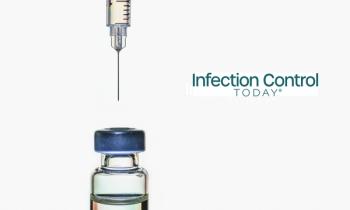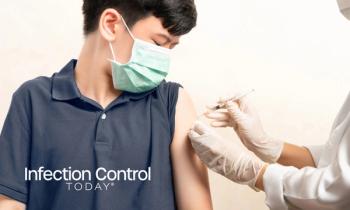
Touch Screens: The High-Touch Surfaces Hiding in Plain Sight
In order to effectively achieve a safe healthcare environment where frequently used touch screen technology is both ubiquitous and mobile, education must be provided to highlight the appropriate products and practices for cleaning/disinfection and hand hygiene.
Cleaning and disinfection of high-touch surfaces and devices within the healthcare environment have long been a focus of infection prevention given the role of these surfaces in the transmission of microbes. Certainly, now more than ever, addressing the concerns of SARS-CoV-2, the virus causing COVID-19 infection, an appropriate and effective surface cleaning/disinfection product and protocol are paramount to keeping patients, staff and visitors to healthcare facilities safe and infection free.
Traditionally, when we think about the healthcare environment, the predominant infection prevention tactics have been hand hygiene and surface cleaning and disinfection. The healthcare landscape is rapidly changing and now includes high-touch technologies. Cell phones have infiltrated this setting in both a professional capacity to assist the healthcare professional (HCP) with patient care and for personal communication. Over the past decade, cell phone use amongst HCP has been steadily increasing. Physician reports of using phones for professional purposes have increased from 68% in 2012 to 84% in 2015.2
Cell phones used in healthcare can improve communication in the working environment and improve information access, placing clinical data at the fingertips of the HCP and the patients.3It should also be mentioned that this technology can come in direct contact with the patient. Many facilities utilize touchscreen tablets for patient registration (where the patient uses the tablet to sign in/enter personal information) and for tele-health consultation with an admitted patient (if the physician is not able to assess the patient in person for an urgent issue).
There can be drawbacks to the use of cell phones in patient care areas, despite the resources they can provide with the tap of a finger. One such drawback is the potential for infection transmission-organisms can live on the device surface for prolonged periods of time. One meta-analysis reviewing the literature between 2005-2013 highlighted 39 studies that identified possible nosocomial infection organisms on cell phones of HCPs, with the most common isolate identified being Staphylococcus aureus.4 Looking at Staphylococcus aureus, Kanayama, et al (2017) found that genetically identical isolates were found on both the cell phone and its user, proving that cell phones can serve as microbial reservoirs for infection in the healthcare setting.5 To further support this point, it has been reported that 73.7% of mobile hand-held devices (MHDs) tested were colonized with bacteria6, while another study reported that 100% of the bacteria found on MHDs was also on the HCP hands.7
Bacteria are not the only microbes found on cell phones. A study looking at viral transfer between fingers and glass surfaces found that transmission can, in fact, occur and the amount of transfer is significantly impacted by virus species and the time since the last handwashing event.8This is an incredibly pertinent finding in the current world of COVID-19 infection. Pillet, et al looked at mobile phone contamination by epidemic viruses (metapneumovirus, respiratory syncytial virus, influenza viruses, rotavirus and norovirus) and found that these devices can be reservoirs for viral RNA, concluding that hand hygiene and cleaning and disinfection of these devices are needed.9
The Kanayama, et al study concludes “surface contamination of mobile phones likely occurs when these devices are used with bare hands or gloved hands after contact with a patient” and stresses the importance of hand hygieneafterusing these often contaminated devices and priorto patient contact to stop the potential for transmission.”5 The World Health Organization’s (WHO) 5 Moments for Hand Hygiene model is a great template for facilities to follow to prevent healthcare associated infections (HAIs) caused by inadvertent cross contamination via cell phone use:10
1. Before touching a patient,
2. Before clean/aseptic procedures,
3. After body fluid exposure/risk,
4. After touching a patient, and
5. After touching patient surroundings.
In order to effectively achieve a safe healthcare environment where frequently used touch screen technology is both ubiquitous and mobile, education must be provided to highlight the appropriate products and practices for cleaning/disinfection and hand hygiene. This educational strategy must include cell phones!
There has long been a void in guidance regarding the cleaning of cell phones in the healthcare setting. The Association of peri-Operative Registered Nurses (AORN) recently published guidelines to address the importance of cleaning cell phones, tablets, and other hand-held electronic equipment prior to them being introduced to sterile environments: “Clean cell phones, tablets, and other personal communication or hand-held electronic equipment according to the device manufacturer’s instructions for use before these items are brought into the OR, and perform hand hygiene.”11 Given what we know about pathogen transmission and the use of high touch technologies, the practice of cleaning these devices should extend throughout the healthcare facility to include all patient care areas.
Education and guidance around the practice of cleaning and disinfection of these devices is paramount to support compliance. “To err is human” asserts that the problem is not bad people in health care-it is that good people are working in bad systems that need to be made safer.12 Providing a system with guidelines around appropriate cleaning/disinfection of these high touch mobile devices, and then educating staff to these guidelines is an ideal way to bolster compliance with practice.
Recently, a survey amongst 100 nurses across a wide range of direct care hospital settings was conducted.13 The findings showed that cell phones are not disinfected as often as they should be given the organisms we know they harbor:
· 72% of nurses reported using their cell phones at nursing stations, 76% used them in public areas such as the cafeteria, and 50% used them in bathrooms
· 84% of nurses reported frequently touching their cell phone during shift without gloves on
· 41% of nurses reported cleaning their phones routinely throughout the day
These numbers are most likely due to the lack of formal compliance training:
· Only 3% of respondents received formal training on sanitizing their cell phones
· Only 25% of respondents think there is a significant need for hospitals to have stricter policies and procedures to prevent contamination of these hand-held, high touch devices
The silver lining to this data is that it was found that when nurses do clean their phones, they typically use a disposable alcohol-based wipe (we’ll discuss this more in a minute). Overall, these findings highlight that once practices are reviewed, gaps can be identified, and education and planning can be initiated for ultimate mitigation. Visual educational tools-such as laminated reminders posted on walls, and computer-based learning modules, can assist with HCP compliance with cell phone cleaning.
Cleaning and disinfection practices within the healthcare environment have been heightened during this pandemic. A practice that should always be performed in the healthcare environment has been put under an international microscope. The SARS-CoV-2 pandemic has motivated the most well-known cell phone manufacturers to provide detailed cleaning procedures-both Apple and Samsung have made cleaning recommendations for products found to be compatible with their phones. Apple has approved the use of 70% isopropyl alcohol wipes, as has Samsung.14,15 This manufacturer guidance couldn’t come at a better time. Information on appropriate cleaning products, paired with internal policy to support frequent cleaning AND hand hygiene, will help reduce the risk of cell phones as a reservoir for infection transmission.
Holly Montejano, MS, CIC, CPHQ, VA-BC, is a clinical science liaison with PDI Healthcare.
References:
1. US Centers for Disease Control and Prevention. Healthcare-Associated Infections Data Portal. CDC website.
2. Statistica Research Department. Physicians' usage of smartphones for professional purposes in the US from 2012 to 2015. Statistica website.
3. Farrell M. Use of iPhones by nurses in an acute care setting to improve communication and decision-making processes: qualitative analysis of nurses’ perspectives on iPhone use. JMIR Mhealth Uhealth. 2016 Apr-Jun; 4(2): e43. Published online 2016 May 31. doi: 10.2196/mhealth.5071.
4. Ulger, Fatma, Dilek A, Esen S, Sunbul M, Leblebicioglu H. Are healthcare workers’ mobile phones a potential source of nosocomial infections? Review of the literature. J Infect Dev Ctries. 2015 Oct 29;9(10):1046-53. doi: 10.3855/jidc.6104.
5. Kanayama AK, Takahashi H, Yoshizawa S, Tateda K, Kaneko A, Kobayashi I. Staphylococcus aureus surface contamination of mobile phones and presence of genetically identical strains on the hands of nursing personnel. Am J Infect Control. 2017 Aug 1;45(8):929-931. doi: 10.1016/j.ajic.2017.02.011. Epub 2017 Apr 11.
6. Heyba M, Ismaiel M, Alotaibi A, et al. Microbiological contamination of mobile phones of clinicians in intensive care units and neonatalcare units in public hospitals in Kuwait. BMC Infect Dis. 2015 Oct 15;15:434. doi: 10.1186/s12879-015-1172-9.
7. Pal S, Juyal D, Adekhandi S, et al. Mobile phones: Reservoirs for the transmission of nosocomial pathogens. Adv Biomed Res. 2015 Jul 27;4:144. doi: 10.4103/2277-9175.161553. eCollection 2015.
8. Julian, TR, Leckie JO, Boehm AB. Virus transfer between finger pads and fomites. J Appl Microbiol. 2010 Dec;109(6):1868-74. doi: 10.1111/j.1365-2672.2010.04814.x.
9. Pillet S, Berthelot P, Gagneux-Brunon A, et al. Contamination of healthcare workers' mobile phones by epidemic viruses. Clin Microbiol Infect. 2016 May;22(5):456.e1-6. doi: 10.1016/j.cmi.2015.12.008. Epub 2015 Dec 20.
10. World Health Organization. My 5 Moments for Hand Hygiene. WHO website.
11. AORN. Perioperative Guidelines for Surgical Attire. AORN website.
12. Kohn LT, Corrigan J, Donaldson MS. To err is human: building a safer health system. Vol. 6. Washington, DC: National Academy Press; 2000.
13. PDI Healthcare. 9 stats on cell phone cleaning in hospitals: results from our survey of 100 nurses. PDI website.
14. Apple Support. Cleaning your iPhone. Apple website.
15. Samsung. Samsung guide on how to clean your phone to protect against coronavirus. Samsung website.
Newsletter
Stay prepared and protected with Infection Control Today's newsletter, delivering essential updates, best practices, and expert insights for infection preventionists.






